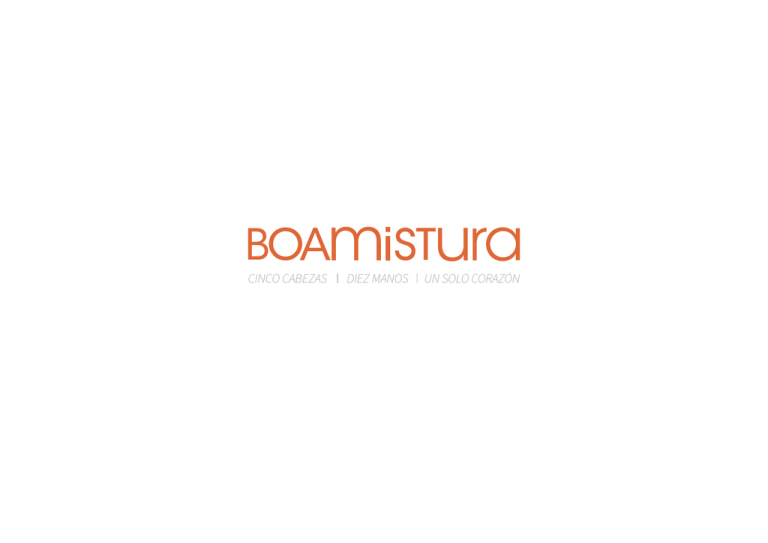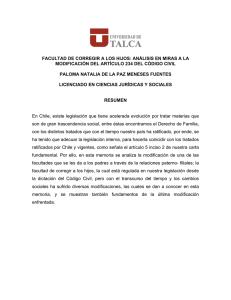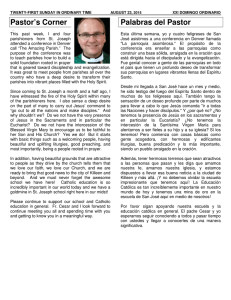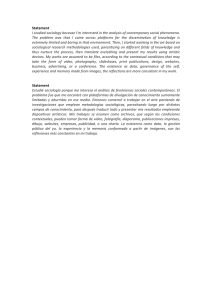cinco cabezas un solo corazón diez manos
Anuncio

CINCO CABEZAS DIEZ MANOS UN SOLO CORAZÓN We are a multidisciplinary team with roots in graffiti, born in late 2001 in Madrid, Spain. We develope our work mainly in the public space. We have carried out projects in South Africa, USA, UK México, Norway or Panamá. We met at 15, when we painted the walls of our neighborhood. We are friends.Our headquarter is in Madrid but we spend the day from here to there, between paintbuckets, computers and pingpong games. We love what we do. We understand our work as a tool for transforming the street and creating bondings between people. We feel that we have a responsibility with the city and time where we live. We’ve been invited to show our work to the Biennale di Venezia, and the Biennial of South of Panamá, and taken part in exhibitions in Art Centers such as the Reina Sofía Museum, Casa Encendida, DA2 Museum or CAC Málaga. Right now we collaborate with Ponce+Robles Gallery in Madrid. We have collaborated with foundations such as ONCE (Spanish national organisation for the blind), and some others have acquired artworks by us, like Oxfam Intermon, Antonio Gala or Universidad de Alcalá. We’ve given lectures at TEDxMadrid and some others Art and social transformation simposiums. Also at Universities such as Complutense de Madrid, TEC de Monterrey, Menéndez Pelayo or Universidad de Sevilla. The term “Boa Mistura”, from the portuguese for “good mixture”, refers to the diversity of style and perspectives of each member. Javier Serrano Guerra. Architect from ETSAG in Madrid who specialised in landscape design at the IUAV in Venice. Juan Jaume Fernández. Graduated in Fine Art, specialising in photography and video, from the University of the Arts in Berlin. Pablo Ferreiro Mederos. Graduated in Fine Art, specialising in graphic design, from the Aalto University of Art and Design in Helsinki. Pablo Purón Carrillo. An illustrator who graduated in Advertising and Public Relations from the URCJ in Madrid. Rubén Martín de Lucas. Civil engineer from the UPM in Madrid, and painter. LUZ NAS VIELAS São Paulo, Brasil. ETAPA CROSSROADS El Proyecto “Luz Nas Vielas” ha sido realizado en Vila Brasilândia, Sâo Paulo, durante el mes de Enero de 2012. Forma parte de la serie CROSSROADS: Proyectos de Arte Urbano participativo con los que el colectivo pretende intervenir en comunidades desfavorecidas empleando el arte como herramienta de cambio e inspiración. Tuvimos la oportunidad de vivir en Brasilândia, acogidos por la familia Gonçálves, y acceder al contacto directo con la comunidad. Tras un estudio y análisis previo, definen como marco de actuación las callejuelas que sirven de elementos conectores en el tejido urbano, conocidas como “vielas” y “becos”. El diálogo con los moradores y su participación activa han sido determinantes en la dirección del Proyecto. BELEZA, FIRMEZA, AMOR, DOÇURA y ORGULHO son los conceptos elegidos por el colectivo para las intervenciones. LUZ NAS VIELAS ha sido posible gracias al Patrocinio de la Embajada de España en Brasil y la colaboración de Singapore Airlines, Montana Colors y el Centro Cultural Español en SP. Los resultados del proyecto se expusieron en São Paulo durante la Virada Sustentável el 4 y 5 de Junio de 2012. VILA BRASILANDIA 23° 27’ 30.04” S 46° 41’ 38.54” W Natasha y Anderson en Viela Beleza BOA MISTURA’s project “LUZ NAS VIELAS” has been carried out in Vila Brasilândia, São Paulo, during January 2012. The project is part of the CROSSROADS series: Boa Mistura´s Participative Urban Art Interventions to modify rundown communities using art as a tool for change and inspiration. Between the 4th and 16th of January BOA MISTURA had the opportunity to live in Brasilândia, hosted by the Gonçalves family, having this way direct contact with the community. After preliminary studies and analysis, the defined framework are the narrow and winding streets that connects the urban net, known as VIELAS and BECOS. The dialogue with residents and their active participation has been decisive for the Project. “BELEZA”, “FIRMEZA”, “AMOR”, “DOÇURA” and “ORGULHO” are the concepts chosen by the collective for the interventions. “LUZ NAS VIELAS” has been made possible with the sponsorship of the Embassy of Spain in Brazil and the collaboration of Singapore Airlines, Montana Colors and the Spanish Cultural Center in São Paulo. The results will be presented in São Paulo during the event “Virada Sustentável” the 4th and 5th of June, 2012. Jazmine en Viela Orgulho Viela Beleza antes de la intervención Trabajando en Viela Beleza PROYECTO SIMBIOSIS Diferentes localizaciones. talleres y murales. Serie de murales participativos realizados en dos fases: una primera de trabajo conjunto generando un mural con todos los participantes, y una segunda, en la que nosotros pintamos con blanco, cubriendo parcialmente el mural. El resultado es una palabra o una frase que enmarca partes del mural de fondo. “INSPIRAÇÃO” en Río de Janeiro, “ALEGRÍA” en Argel o “PORQUE SUEÑO, NO ESTOY LOCO” en Zaragoza son algunos de los murales que hemos hecho. Participative mural series consisting in two stages: a first stage is done between all participants, filling the wall with colors. The second one consist on the application of a white paint layer that partially covers the previous work. The result is a word or phrase that frames some parts of the background. “INSPIRAÇÃO” in Rio de Janeiro, “HAPPINESS” in Algiers or “I DREAM, THEN I’M NOT CRAZY” in Zaragoza are some of the murals we’ve done. C/ de La Rioja 1 40° 27’ 15.13” N 3° 35’ 34.67” W Proceso de trabajo Detalles del fondo en la primera fase Favela do vidigal, Río de janeiro 22° 59’ 44.85” S 43° 14’ 42.66” W Madrid Argel C/ SANTIAGO, 24. ZARAGOZA 41° 39’ 19.09” N 0° 52’ 42.08” W Khelifa Boukhalfa St, 36° 46’ 04.02” N 03° 03’ 17.34” E SOMOS LUZ Barrio del chorrillo, Panamá. etapa crossroads Somos Luz es el mensaje con el intervinimos, ayudados por los propios vecinos, las 50 viviendas del edificio Begonia I en el barrio de El Chorrillo (Panamá ciudad). Inspirados en la identidad del barrio, tomamos como punto de partida la retícula de colores que se genera de forma espontánea al pintar cada vecino la porción del edificio que entiende como suya. Modificando esta retícula al introducir la tipografía se pierde la unidad de vivienda para ganar en concepto de comunidad. El mensaje busca inspirar diariamente no sólo a los vecinos sino también al resto de personas que pasen cerca del edificio y recordarles que cada persona tiene un valor incalculable, independientemente de la realidad del lugar en el que vivan. Avda. de los poetas, el chorrillo. 08° 56’ 53.00” N Jenesí y Yahomi 79° 32’ 47.57” W “Somos Luz” (“We are Light”) is the message painted on 50 houses at the building Begonia I in the neighborhood of El Chorrillo (Panama City). It´s been made Boa Misturas, together with the neighbors help. We were inspired by the neighborhood identity. The starting point is the color grid spontaneously generated by every neighbor when they paint only the part of the building that they understand as his house. The new typography layer modifies this grid losing the housing unit in favor of the community concept. The message aims to inspire daily. Not only the neighbors, but other people that walk every day by the building, reminding them that every person is invaluable, regardless the reality where they live. Genesí Edificio Begonia I, antes Estudio cromático basado en los colores originales de la comunidad Selección de muestras Elena Nathani La escala de la obra (más de 2000m2 pintados) permite que sea habitada, cambiando a cada instante por la interacción con ella. No se trata sólo de la fachada, los corredores y núcleos de escaleras han sido también intervenidos, convertidos así en abstractas composiciones de color que cobran vida con la ropa tendida o cuando alguien se asoma al balcón. El proyecto, impulsado por la Bienal del Sur en Panamá, forma parte de la serie CROSSROADS, con la que Boa Mistura está utilizando el Arte Urbano participativo como herramienta dinamizadora en comunidades carentes, implicando a los vecinos en la mejora de su propio espacio vital. The scale of the work (more than 2.000 m2) allows it to be inhabited, changing at every moment with the interaction with it. It is not just the façade, corridors and stairways were also painted and converted into abstract color compositions that are the new environment for daily scenes like clothes hanging or people at the balcony. The project was sponsorized by the Bienal del Sur in Panamá, and is part of the CROSSROADS series, in which Boa Mistura is using participative urban art as a tool for encourage in run down communities, working with the local residents in the improvement of their own space. Capa tipográfica Capa cromática Alzado SOMOS LUZ Kelsy SANCRISDECOLORES SAN CRISTÓBAL de los ángeles, madrid Esta es la historia de un lugar abandonado y olvidado de San Cris que se convirtió, gracias a los jóvenes, vecinos y amigos, en un espacio urbano extraordinario para el barrio Autobarrios es un proyecto del colectivo de arquitectos BASURAMA, en el que hemos tenido la oportunidad de colaborar. Autobarrios estimula nuestro imaginario colectivo, nuestra autonomía y nuestra capacidad para intervenir en nuestras redes cotidianas y el entorno próximo. This is the story of a forgotten place at the neighborhood of “San Cris” that turned out into an extraordinary urban space for the community thanks to the neighbors and friends. “Autobarrios” is a project by the architecture studio BASURAMA, in wich we have had the chance to collaborate. Autobarrios stimulates our collective imagination, our autonomy and our capablility to intervene in our everyday network and our inmadiate surroundings. C/ Burjasot, MADRID 40° 20’ 42.48” N 03° 41’ 34.66” W Estudio de pilar para “SANCRISDECOLORES” Maquetas de los pilares Espacio de intervención antes r2hox r2hox r2hox r2hox PROYECTO LAS AMÉRICAS Querétaro, méxico. etapa crossroads La colonia de las Américas se encuentra en la periferia de Querétaro. Es una comunidad humilde, de gente trabajadora, con carencias pero con una fuerza especial en su gente. Cuenta con las dotaciones básicas y con una agitada vida interior de pequeño comercio: “Misceláneas”, taquerías y cantinas de “comida corrida” han hecho que nuestra vida allí fuese muy sencilla. La colonia se encuentra en dos laderas de un cerro, tiene forma de “boomerang” dando fachada a las dos principales autopistas del Estado: La 5 de Febrero y la Bernardo Quintana, que confluyen exactamente en el vértice de Las Américas por lo que diariamente es vista por miles de personas. The colony of “Las Americas” is located at the outskirts of the city of Querétaro. It is a working class humble community, with some needs, but with a very special strength in its people. It has the basic resources and a very active shopping life: “Miscelaneas” (groceries), “Taquerías” and “Cantinas”, that made our life there easier. The colony is located on two sides of a hill, it has a “boomerang” shape, and its façades face the two main state highways: “5 de Febrero” and “Bernardo Quintana”. This two roads converge exactly at the vertex of “Las Américas”, so the community is daily seen by thousands of people. C/ Peña de bernal, santiago de querétaro 20° 37’ 22.38”N 100° 25’ 13.77”W Andrea trabajando en su comunidad El proyecto pretende hacer una intervención paisajística que refuerce el concepto de identidad de la colonia. Los Otomíes han sido la principal fuente de inspiración. Es el pueblo indígena que tiene sus raíces allí y sentíamos que si escarbábamos un poco encontraríamos alguno de sus maravillosos textiles. El color que ha teñido las casas tiene su origen en su artesanía. Nos hemos dejado seducir también por el universo de estampados y de psicodelia de las calacas, los huicholes y los alebrijes, que han inspirado las tramas que hemos ido generando y que muchos de los vecinos han escogido para que envolviese su casa. Alebrije Huichol Calaca Tejido The project aims to make a landscape intervention, that reinforces the concept of colony identity. The Otomí town have been the main source of inspiration. That is the native people whose roots are in that area, and we felt that if we research in that direction we would find out inspiration in their fabulous textiles. The color that has tinted the houses has the origin in their crafts. We got seduced also by the complex universe of patterns and psychedelia of the “calacas”, “huicholes” and “alebrijes”, that have inspired the patterns we have generated, and that a lot of neighbors have chosen to cover their homes. Tapete Otomí Propuesta de tramas Fotomontaje con propuesta de actuación sobre todo el cerro Fotomontaje con propuesta de actuación sobre las primeras manzanas Voluntarios trabajando en la calle Peña de Bernal Resultado de la intervención en la calle Peña de Bernal En esta primera fase hemos podido intervenir 30 viviendas de Las Américas gracias a los vecinos y a la increíble ayuda de las decenas de voluntarios de toda la ciudad que vinieron a ayudarnos. El sueño sería poder intervenir las 1074 casas de la comunidad. El proyecto ha sido llevado a cabo gracias a la Fundación PROART y al Instituto de Creatividad, Cultura, Arte y Desarrollo de Querétaro. In this first stage we could intervene only around 30 houses of “Las Américas”, thanks to the help of the neighbors and the amazing collaboration of dozens of volunteers from all over the city that came to help us. The project has been carried out thanks to the PROART Foundation and the ICCAD (Institute for Creativity, Culture, Arts and Development from Querétaro). Aspecto final del proyecto piloto, con unas 30 viviendas realizadas en la calle Peña de Bernal. www.boamistura.com hola@boamistura.com (+34) 91 204 66 78 Estudio (+34) 669 01 01 36 Javier (+34) 616 69 45 12 Juan






